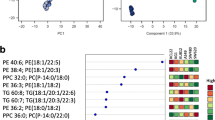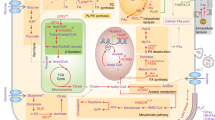Abstract
Oxygen-requiring enzymes, such as Δ4-desaturase (dihydroceramide desaturase), sphingolipid Δ4-desaturase/C-4-hydroxylase, and fatty acid 2-hydroxylase are involved in ceramide synthesis. We prepared free ceramides, sphingomyelins and glycosphingolipids (GSLs) from cancer cells cultivated under conditions of normoxia and hypoxia, and analyzed these compounds using matrix-assisted laser desorption/ionization time-of-flight mass spectrometry. Human colon cancer LS174T cells were employed because these cells highly express hydroxyl fatty acids and phytosphingosine (t18:0) which are expected to be greatly influenced by changes in oxygen levels. As expected, the populations of dihydro-species of free ceramide and sphingomyelin with C16:0 non-hydroxy fatty acid were elevated, and the populations of HexCers and Hex2Cers, composed of C16:0 or C16:0 hydroxy fatty acid (C16:0h), and sphingosine (d18:1) or t18:0, were decreased under hypoxia. However, appreciable populations of HexCer and Hex2Cer species of C24:0 or C24:0h and t18:0 remained. These results suggest that the individual species of GSLs with fatty acids possessing different alkyl chain lengths, either non-hydroxy fatty acids or hydroxyl fatty acids, may be metabolized individually.






Similar content being viewed by others
References
Nishimura, K.: Phytosphingosine is a characteristic component of the glycolipids in the vertebrate intestine. Comp. Biochem. Physiol. B 86, 149–154 (1987)
Yoneshige, A., Sasaki, A., Miyazaki, M., Kojima, N., Suzuki, A., Matsuda, J.: Developmental changes in glycolipids and synchronized expression of nutrient transporters in the mouse small intestine. J. Nutr. Biochem. 21, 214–226 (2010)
Tanaka, K., Tamiya-Koizumi, K., Yamada, M., Murate, T., Kannagi, R., Kyogashima, M.: Individual profiles of free ceramide species and the constituent ceramide species of sphingomyelin and neutral glycosphingolipid and their alteration according to the sequential changes of environmental oxygen content in human colorectal cancer Caco-2 cells. Glycoconj. J. 31, 209–219 (2014)
Tanaka, K., Yamada, M., Tamiya-Koizumi, K., Kannagi, R., Aoyama, T., Hara, A., Kyogashima, M.: Systematic analyses of free ceramide species and ceramide species comprising neutral glycosphingolipids by MALDI-TOF MS with high-energy CID. Glycoconj. J. 28, 67–87 (2011)
Saito, T., Hakomori, S.I.: Quantitative isolation of total glycosphingolipids from animal cells. J. Lipid Res. 12, 257–259 (1971)
Kyogashima, M., Tadano-Aritomi, K., Aoyama, T., Yusa, A., Goto, Y., Tamiya-Koizumi, K., Ito, H., Murate, T., Kannagi, R., Hara, A.: Chemical and apoptotic properties of hydroxy-ceramides containing long-chain bases with unusual alkyl chain lengths. J. Biochem. 144, 95–106 (2008)
Rylova, S.N., Somova, O.G., Zubova, E.S., Dudnik, L.B., Kogtev, L.S., Kozlov, A.M., Alesenko, A.V., Dyatlovitskaya, E.V.: Content and structure of ceramide and sphingomyelin and sphingomyelinase activity in mouse hepatoma-22. Biochemistry (Mosc) 64, 437–441 (1999)
Dyatlovitskaya, E.V., Kandyba, A.G., Kozlov, A.M., Somova, O.G.: Sphinganine in Sphingomyelins of tumors and mouse regenerating liver. Biochemistry (Mosc) 66, 502–504 (2001)
Kyogashima, M., Taketomi, T.: Lipids from human platelets in primary thrombocythemia. Jpn. J. Exp. Med. 56, 113–118 (1986)
Devlin, C.M., Lahm, T., Hubbard, W.C., Van Demark, M., Wang, K.C., Wu, X., Bielawska, A., Obeid, L.M., Ivan, M., Petrache, I.: Dihydroceramide-based response to hypoxia. J. Biol. Chem. 286, 38069–38078 (2011)
Domonand, B., Costello, C.E.: A systematic nomenclature for carbohydrate fragmentations in FAB-MS/MS spectra of glycoconjugates. Glycoconj. J. 5, 397–409 (1988)
Airley, R.E., Mobasheri, A.: Hypoxic regulation of glucose transport, anaerobic metabolism and angiogenesis in cancer: novel pathways and targets for anticancer therapeutics. Chemotherapy 53, 233–256 (2007)
Michel, C., van Echten-Deckert, G., Rother, J., Sandhoff, K., Wang, E., Merrill Jr., A.H.: Characterization of ceramide synthesis. A dihydroceramide desaturase introduces the 4,5-trans-double bond of sphingosine at the level of dihydroceramide. J. Biol. Chem. 272, 22432–22437 (1997)
Ternes, P., Franke, S., Zahringer, U., Sperling, P., Heinz, E.: Identification and characterization of a sphingolipid delta4-desaturase family. J. Biol. Chem. 277, 25512–25518 (2002)
Mizutani, Y., Kihara, A., Igarashi, Y.: Identification of the human sphingolipid C4-hydroxylase, hDES2, and its up-regulation during keratinocyte differentiation. FEBS Lett. 563, 93–97 (2004)
Enomoto, A., Omae, F., Miyazaki, M., Kozutsumi, Y., Yubisui, T., Suzuki, A.: Dihydroceramide:sphinganine C-4-hydroxylation requires Des2 hydroxylase and the membrane form of cytochrome b5. Biochem. J. 397, 289–295 (2006)
Alderson, N.L., Rembiesa, B.M., Walla, M.D., Bielawska, A., Bielawski, J., Hama, H.: The human FA2H gene encodes a fatty acid 2-hydroxylase. J. Biol. Chem. 279, 48562–48568 (2004)
Kota, V., Hama, H.: 2′-Hydroxy ceramide in membrane homeostasis and cell signaling. Adv. Biol. Regul. 54, 223–230 (2014)
Kyogashima, M., Tamiya-Koizumi, K., Ehara, T., Li, G., Hu, R., Hara, A., Aoyama, T., Kannagi, R.: Rapid demonstration of diversity of sulfatide molecular species from biological materials by MALDI-TOF MS. Glycobiology 16, 719–728 (2006)
Tidhar, R., Futerman, A.H.: The complexity of sphingolipid biosynthesis in the endoplasmic reticulum. Biochim. Biophys. Acta 1833, 2511–2518 (2013)
Mizutani, Y., Kihara, A., Chiba, H., Tojo, H., Igarashi, Y.: 2-Hydroxy-ceramide synthesis by ceramide synthase family: enzymatic basis for the preference of FA chain length. J. Lipid Res. 49, 2356–2364 (2008)
Hanada, K.: Intracellular trafficking of ceramide by ceramide transfer protein. Proc. Jpn. Acad. Ser. B Phys. Biol. Sci. 86, 426–437 (2010)
Taniguchi, M., Okazaki, T.: The role of sphingomyelin and sphingomyelin synthases in cell death, proliferation and migration-from cell and animal models to human disorders. Biochim. Biophys. Acta 1841, 692–703 (2014)
Giussani, P., Colleoni, T., Brioschi, L., Bassi, R., Hanada, K., Tettamanti, G., Riboni, L., Viani, P.: Ceramide traffic in C6 glioma cells: evidence for CERT-dependent and independent transport from ER to the Golgi apparatus. Biochim. Biophys. Acta 1781, 40–51 (2008)
Ishibashi, Y., Kohyama-Koganeya, A., Hirabayashi, Y.: New insights on glucosylated lipids: metabolism and functions. Biochim. Biophys. Acta 1831, 1475–1485 (2013)
Honke, K.: UDP-Gal: ceramide galactosyltransferase (UGT8). In: Taniguchi, N., Honke, K., Fukuda, M., et al. (eds.) Handbook of glycosyltransferases and related genes, pp. 131–140. Springer, Tokyo (2014)
D’Angelo, G., Uemura, T., Chuang, C.C., Polishchuk, E., Santoro, M., Ohvo-Rekilä, H., Sato, T., Di Tullio, G., Varriale, A., D’Auria, S., Daniele, T., Capuani, F., Johannes, L., Mattjus, P., Monti, M., Pucci, P., Williams, R.L., Burke, J.E., Platt, F.M., Harada, A., De Matteis, M.A.: Vesicular and non-vesicular transport feed distinct glycosylation pathways in the Golgi. Nature 501, 116–120 (2013)
Yamaji, T., Hanada, K.: Sphingolipid metabolism and interorganellar transport: localization of sphingolipid enzymes and lipid transfer proteins. Traffic 16, 101–122 (2015)
Fabrias, G., Muñoz-Olaya, J., Cingolani, F., Signorelli, P., Casas, J., Gagliostro, V., Ghidoni, R.: Dihydroceramide desaturase and dihydrosphingolipids: debutant players in the sphingolipid arena. Prog. Lipid Res. 51, 82–94 (2012)
Hakomori, S.I.: Structure and function of glycosphingolipids and sphingolipids: recollections and future trends. Biochim. Biophys. Acta 1780, 325–346 (2008)
Karlsson, K.A.: Pathogen-host protein-carbohydrate interactions as the basis of important infections. Adv. Exp. Med. Biol. 491, 431–443 (2001)
Kannagi, R., Stroup, R., Cochran, N.A., Urdal, D.L., Young Jr., W.W., Hakomori, S.: Factors affecting expression of glycolipid tumor antigens: influence of ceramide composition and coexisting glycolipid on the antigenicity of gangliotriaosylceramide in murine lymphoma cells. Cancer Res. 43, 4997–5005 (1983)
Kyogashima, M., Ginsburg, V., Krivan, H.C.: Escherichia coli K99 binds to N-glycolylsialoparagloboside and N-glycolyl-GM3 found in piglet small intestine. Arch. Biochem. Biophys. 270, 391–397 (1989)
Madar Johansson, M., Coddens, A., Benktander, J., Cox, E., Teneberg, S.: Porcine intestinal glycosphingolipids recognized by F6-fimbriated enterotoxigenic Escherichia coli. Microb. Pathog. 76, 51–60 (2014)
Author information
Authors and Affiliations
Corresponding author
Rights and permissions
About this article
Cite this article
Tanaka, K., Tamiya-Koizumi, K., Yamada, M. et al. Hypoxia remodels the composition of the constituent ceramide species of HexCer and Hex2Cer with phytosphingosine and hydroxy fatty acids in human colon cancer LS174T cells. Glycoconj J 32, 615–623 (2015). https://doi.org/10.1007/s10719-015-9607-5
Received:
Revised:
Accepted:
Published:
Issue Date:
DOI: https://doi.org/10.1007/s10719-015-9607-5




